BUDDHIST PILGRIMAGE TO INDIA AND NEPAL
“In the Master’s Footsteps” 24 Nov - 5 Dec 2014 (12D/11N)
Five holy places of Buddhist Pilgrimage:
(1) Lumbini in Nepal, the Buddha's birthplace
(2) Bodhgaya in India, the Buddha's enlightenment
(3) Sarnath in India, the Buddha's first sermon
(4) Vaishali Kothua in India, the Buddha's last sermon
(5) Kushinagar in India, the Buddha's passing away
Early morning meditation beneath the Mahabodhi Temple Bodhi Tree led by Elaine Low.
Day 3 (26-11-2014) Bodhgaya to Rajgir (80km 3hrs' drive)
The hotel morning call was at 4am and we had to be at the lobby by 4.45am. At 5.00am the bus took us to the Mahabodhi Temple. We sat beneath the Bodhi Tree for our chanting and meditation. We returned to the hotel at 6.00am for breakfast and then left for Rajgir at 7.15am. Rajgir the place of taming the drunken elephant Nalagiri.
At 9.50am we arrived at the site of the Chariot Wheel Marks and Shell Characters. At 10.20am returned to the hotel for a 15 minutes' toilet break and then proceeded to visit the Veluvana (Bamboo Grove). We had a group photo taken there followed by chanting, meditation and listening to good commentaries by our group leader Datuk Seri Dr. Victor Wee.
At 12.00 noon we returned to the hotel for lunch. At 1.30pm we visited the Sattapanni Caves, the site of the First Buddhist Council which was held 3 months after the Buddha’s Mahaparinibbana in 543 B.C. situated on top of the Vebhara Hill. We returned to the hotel at 5.00pm and had dinner at 6.00pm.
Lunch / Dinner and overnight at Hotel Rajgir Residency, Rajgir
Buddhist Monks and devotees meditating and chanting at the Mahabodhi Temple compound.
Buddhist Monks and devotees meditating and chanting at the Mahabodhi Temple compound.
Passing through the Niranjana River on the road to Rajgir an ancient city in Indian state of Bihar.
We stopped halfway for toilet behind some bushes on the road to Rajgir.
Notice the 3pax on the bike? "If Malaysia Boleh, India is Incredible".
Looking at this Indian Rajgir villages, they are 50 years behind time as compared to Malaysia.
Looking at this Indian Rajgir villages, they are 50 years behind time as compared to Malaysia.
Overloaded tricycle on the road to Rajgir an ancient city in Indian state of Bihar.
This Archeological area indicates some parts of Chariot Wheel Mark and Shell Inscriptions. These Shell Inscriptions, which have been found in many places in Rajgir and Northern India, have not yet been deciphered. Probably these shell inscriptions belong to 4th or 5th century A.D. According to legend the chariot wheel marks belong to the Mahabharata Period.
Ancient Chariot Wheel tracks - Many pilgrims visit the Chariot Route and see the shell inscriptions, marveling at the uniqueness of the phenomenon. The chariot tracks consist of two parallel furrows cut deep into the rocks for about thirty feet distance caused possibly by the large number of chariots that came to deliver goods to Rajgir.
Ancient Chariot Wheel tracks - Some locals believe that the ruts had been "burnt" into the rock by the speed and power of Lord Krishna's chariot when he entered the city of Rajgir during the epic Mahabharata times.
This Archeological area indicates some parts of Chariot Wheel Mark and Shell Inscriptions.
This Archeological area indicates some parts of Chariot Wheel Mark and Shell Inscriptions.
Horse cart on the road to Rajgir an ancient city in Indian state of Bihar.
At Hotel Rajgir Residency, Rajgir for a 15 minutes' toilet break.
Veluvana (Bamboo Grove) and Karanda Tank
A large mound to the left of the main entrance is the cemetery believed to be the site of the Veluvana Vihara built by King Bimbisara for the Buddha’s residence. The whole area has been cleaned up and Veluvana now looks like a pleasant park, planted with shade trees, bamboo and flowers, reflecting its original status as the royal park of King Bimbisara.
Veluvana (Bamboo Grove) and Karanda Tank - When King Bimbisara heard that the Buddha had come to Rajgir with a retinue of 1000 Arahants, he went to the Sapling Grove to meet the Buddha and was converted by the Buddha, attaining the First Stage of Sainthood. Thereafter, he invited the Buddha to his palace for the following day’s meal, after which he donated the famous Bamboo Grove or Veluvana, the first donation of a park (arama), to the Buddha and Sangha. In the vicinity of Veluvana is a large pond with a Buddha image at the
centre. This pond is believed to be the site of the Karanda tank
mentioned in Buddhist text as the Karanda Kanivapa where the Buddha used
to take his bath. 
Chanting and meditation at Veluvana (Bamboo Grove) led by group leader Datuk Seri Dr. Victor Wee. 
Chanting and meditation at Veluvana (Bamboo Grove) led by group leader Datuk Seri Dr. Victor Wee.
Chanting and meditation at Veluvana (Bamboo Grove) led by group leader Datuk Seri Dr. Victor Wee.
Chanting and meditation at Veluvana (Bamboo Grove) led by group leader Datuk Seri Dr. Victor Wee.
Chanting and meditation at Veluvana (Bamboo Grove) led by group leader Datuk Seri Dr. Victor Wee. 
BGF group photo at Veluvana (Bamboo Grove) led by group leader Datuk Seri Dr. Victor Wee.
Buddha image at Veluvana, Rajgir, Bihar, India.
Lunch at Hotel Rajgir Residency before we visited the Sattapanni Caves, Rajgir. 
On the trek up to Sattapanni Caves is the pink-hued Hindu temple, Lakshmi Narayan Mandir which has within its grounds the ancient hot springs. Worshipers dedicated the temple, to Lord Vishnu and his consort, Goddess Lakshmi, as the name indicates. In more ancient times, the hot springs had been the site of the Tapodarama, a Buddhist monastery at the time of Gautama Buddha. King Bimbisara also used to take his bath there occasionally.
Originally, pilgrims could experience the hot springs only by taking a dip in the pond at Lakshmi Narayan Mandir temple. Recently, the spring has been tapped at a higher level, allowing water to flow through several ceramic pipes into an indoor pool where people sit together enjoying the water cascading over them. However, the Hindu caretakers prohibit Muslims from using the hot spring bath.
On the trek up towards the Sattapanni Caves from Lakshmi Narayan Mandir Temple. 
On the trek up towards Sattapanni Caves on Vebhara hill, Rajgir. 
On the trek up towards Sattapanni Caves on Vebhara hill, Rajgir.
On the trek up towards Sattapanni Caves on Vebhara hill, Rajgir.
A trek above the hot springs, on the right side of the path uphill, is a remarkable stone structure known locally as the “machan” (watch tower). The structure is roughly cube-shaped with dimensions of 26m long by 25m wide by 7m high and is built of unhewn blocks of stone set on the rock. According to Sir John Marshall who excavated the site in 1905-06, the structure was originally a watchtower and “in after times, when no longer required for defensive purposes, they would afford convenient cells for ascetics to meditate in”.
This “machan” (watch tower) structure is believed to be the Pipphali Stone House, residence of Ven. Maha Kassapa, the Convenor of the First Council. The name ‘Pipphali’ probably refers to the name of Mahakassapa before he became a monk. According to Samyutta V, 78, the Buddha visited Maha Kassapa on one occasion when the latter was ill and expounded the Seven Factors of Enlightenment, upon hearing which, Maha Kassapa recovered from the illness. According to Samyutta iii, 124, Ven. Assaji also once stayed at Pipphali House when he was sick.
The country side and forest view below the “machan” (watch tower) on Vebhara hill, Rajgir. 
Burmese pilgrims on the trek up towards Sattapanni Caves on Vebhara hill, Rajgir.
The Jain temple ruin on the trek up to Sattapanni Caves on Vebhara hill, Rajgir. A Jain temple or Derasar is the place of worship for Jains, the followers of Jainism.
The Jain temple ruin on the trek up to Sattapanni Caves on Vebhara hill, Rajgir. Jainism is an Indian religion that prescribes a path of "ahimsa" - non-violence towards all living beings, and emphasizes spiritual interdependence and equality between all forms of life. Practitioners believe that non-violence and self-control are the means by which they can obtain liberation. Ascetism is a major focus of the Jain faith.
The three main principles of Jainism are : (1) Ahimsa (Non-violence); (2) Anekantvad (Non-Absolutism); and (3) Aparigraha (Non- Possessiveness).
Statue of Rishabhanatha the traditional founder of Jainism at Jain temple ruin, Rajgir.
Statue of Rishabhanatha the traditional founder of Jainism at Jain temple ruin, Rajgir.
Statue of Rishabhanatha the traditional founder of Jainism at Jain temple ruin, Rajgir.
Statue of Rishabhanatha the traditional founder of Jainism at Jain temple ruin, Rajgir.
Statue of Rishabhanatha the traditional founder of Jainism at Jain temple ruin, Rajgir.
Statue of Rishabhanatha the traditional founder of Jainism at Jain temple ruin, Rajgir.
A good view of Rajgir town from the trek of Vebhara hill.
On the front left is our Hotel Rajgir Residency and on the right is the round-shaped Nalanda University.
A good view of Rajgir town from the trek of Vebhara hill.
The Sattapanni Caves in Rajgir, was the site of the First Buddhist Council held three months after the Buddha's Mahaparinibbana in 543B.C. is situated on top of Vebhara Hill, beyond the largest Jains temple.
The Sattapanni Caves in Rajgir, have been sealed off to ensure the safety of visitors. The terrace in front of the caves is about 36.6m long and 10.4m at the widest point. Part of the retaining wall of large unhewn stones on the outer edge can still be seen. 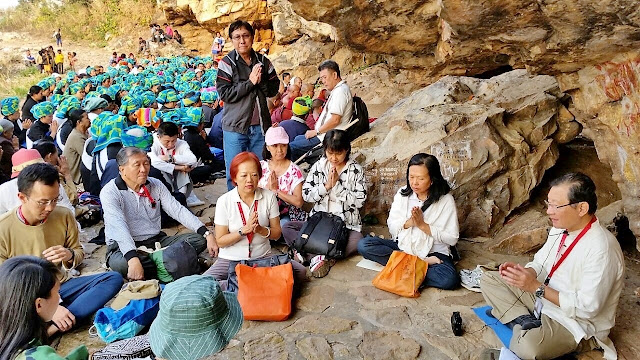
This place agrees with the description of Sattapanni Caves as mentioned in the Pali texts where 500 Arahants convened to codify the Buddha’s Teachings. Over the last 2500 years, a lot of rock erosion might have taken place. As such, the original terrace was probably much larger in those days to have accommodated so many Arahants. 
A good story-telling by group leader Datuk Seri Dr. Victor Wee at Sattapanni Caves in Rajgir.
Chanting and meditating led by our group leader Datuk Seri Dr. Victor Wee at Sattapanni Caves in Rajgir.
Our BGF group listen attentively to Datuk Seri Dr. Victor Wee's story at Sattapanni Caves in Rajgir.
Myanmar pilgrims and monks also came to pray and chant at the Sattapanni Caves in Rajgir.
BGF members and Myanmar pilgrims trekking down Vebhara hill to the foothill village in Rajgir.
Myanmar pilgrim being assisted on her journey down the Vebhara hill in Rajgir.
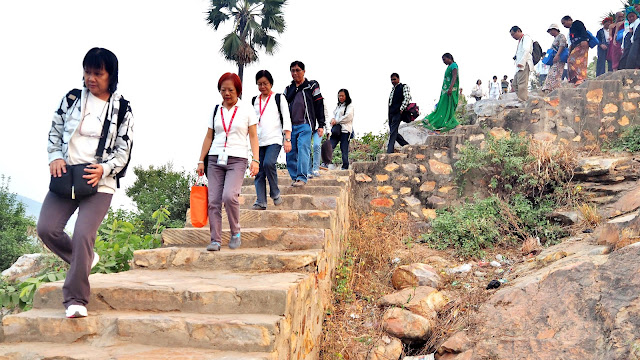
BGF members trekking down Vebhara hill to the foothill village in Rajgir.

A view of the pink-hued Hindu temple called the Lakshmi Narayan Mandir.

The various nuts of India sold at Vebhara foothill village in Rajgir.

BGF members with Myanmar pilgrims at Vebhara foothill village in Rajgir.
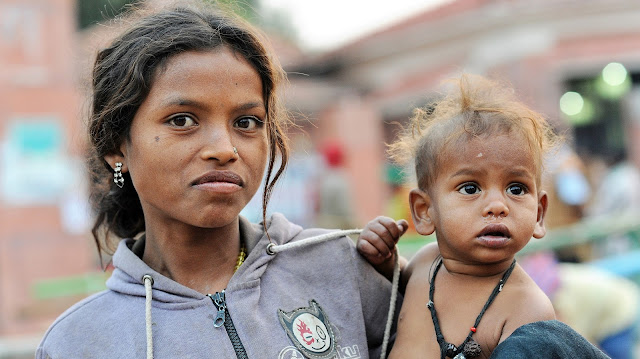
Mother and child at Vebhara foothill village in Rajgir.

People at Vebhara foothill village in Rajgir.

A horse cart at Vebhara foothill village in Rajgir.

It was dinner time at Hotel Rajgir Residency. Eat all you can!

It was dinner time at Hotel Rajgir Residency. Eat all you can!

Delicious capatis for dinner at Hotel Rajgir Residency.

Delicious Indian dishes and recipes to try at Hotel Rajgir Residency.

Delicious Indian dishes and recipes to try at Hotel Rajgir Residency.

Delicious Indian dishes and recipes to try at Hotel Rajgir Residency.

Delicious Indian dishes and recipes to try at Hotel Rajgir Residency.

Delicious Indian dishes and recipes to try at Hotel Rajgir Residency.

Delicious Indian dishes and recipes to try at Hotel Rajgir Residency.

Delicious Indian dishes and recipes to try at Hotel Rajgir Residency.

Delicious Indian dishes and recipes to try at Hotel Rajgir Residency.

All looking good and enjoying the typical Indian cuisine at Hotel Rajgir Residency.

Our big room at Hotel Rajgir Residency, Rajgir.
Rajgir is the modern name of Rajagaha or “royal abode”, an appropriate designation for a place that had remained as the capital of the powerful kingdom of Magadha for centuries. In the Buddha’s time, the ruler was King Bimbisara, who was later usurped by his parricidal son, Ajatasattu. In his first meeting with the Bodhisatta, Bimbisara was so impressed by his royal bearing that he offered to share his kingdom with him. The Bodhisatta, who had just renounced his Sakyan kingdom in search of the Deathless, declined the offer but promised to return to visit Rajgir after he had attained his goal.
Soon after dispatching the Sangha to spread the Dhamma from Sarnath, the Buddha traveled to Uruvela, where he converted the Kassapa brothers and their matted-hair disciples, who all attained Arahantship. With this retinue of a 1000 Arahants, the Buddha entered Rajgir where he received a warm welcome from the King. Thereupon he preached a sermon to King Bimbisra who became a Sotapanna. Next day he invited the Buddha to a meal and offered the Bamboo Garden (Veluvana) to the Buddha and the Sangha.
As the capital of a powerful state, Rajgir was a hive of secular and religious activities. According to the Samannaphala Sutta, many heretical teachers operated in Rajgir, namely: Purana Kassapa, Makkhali Gosala, Ajita Kesakambali, Pakudha Kaccayana, Nigantha Nattaputta and Sanjaya Belatthaputta.
Among the disciples of Sanjaya were two rich brahmins, Upatissa and Kolita, popularly known as Sariputta and Moggallana respectively. Both joined the Sangha after their conversion by the Arahant Assaji, and became the Buddha’s first and second Chief Disciples. Following their conversion, many paribbajakas or wandering ascetics also became followers of the Buddha. Among the laity, the most notable disciples were the royal physician Jivaka, adopted son of Prince Abhaya and the millionaire Upali, a follower of Nigantha Nattaputta, who was sent to convert the Buddha but ended up as a lay disciple instead. Thus, Rajgir became an important centre of Buddhism as the fame of the Buddha spread throughout Magadha.
Rajgir was also the scene of many attempts by Devadatta to kill the Buddha over the leadership of the Sangha.
First he hired archers to assassinate the Buddha, but they ended up by becoming disciples of the Buddha instead.
Next, one day as the Buddha was walking up the slopes of Gijjhakuta (Vulture Peak) Devadatta hurled a rock from the summit at the Buddha but it missed and a splinter wounded the Buddha’s foot.
Finally, he caused the elephant Nalagiri to be intoxicated with liquor and sent the ferocious beast to charge at the Buddha. But the Buddha subdued the animal with his loving kindness. Because of this miracle, Rajgir became sanctified as an important pilgrimage site.
While Devadatta was plotting against the Buddha, Prince Ajatasattu, at his instigation, usurped the throne and imprisoned his father, King Bimbisara in order to starve him to death. He regretted his actions too late, as his father had died before he could release him. Ajatasattu, later at the suggestion of Jivaka, sought the Buddha’s advice and became a lay disciple. After the Buddha’s Mahaparinibbana, he led an army to Kusinara to claim a share of the Buddha’s relics. He was the patron of the First Sangiti or Council held at Sattapanni Cave in Rajgir.
Pilgrimage Itinerary:
Day 01 (24.11.2014) Kuala Lumpur to Bangkok to Bodhgaya, India
Day 02 (25.11.2014) Bodhgaya to Dungeswari Cave - Sujata Stupa - Bodhgaya
Day 03 (26.11.2014) Bodhgaya to Rajgir by coach (80km, 3 hrs drive)
Day 04 (27.11.2014) Rajgir to Gijjhakuta Hill (Vulture Peak) - Nalanda - Rajgir
Day 05 (28.11.2014) Rajgir to Vaishali by coach (130km, 5 hrs drive)
Day 06 (29.11.2014) Vaishali to Kushinagar by coach (180km, 6hrs drive)
Day 07 (30.11.2014) Kushinagar to Lumbini by coach (160km, 7hrs drive)
Day 08 (01.12.2014) Lumbini in, Nepal
Day 09 (02.12.2014) Lumbini to Sravasti by coach (250Km, 8hrs drive)
Day 10 (03.12.2014) Sravasti to Varanasi by coach (270Km, 11 hrs. drive)
Day 11 (04.12.2014) Varanasi to Sarnath. Varanasi to Bangkok TG328 16:30hrs 21:15hrs
Day 12 (05.12.2014) Bangkok to Kuala Lumpur
///







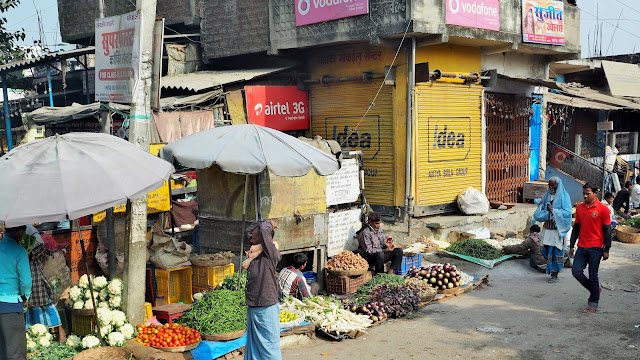




































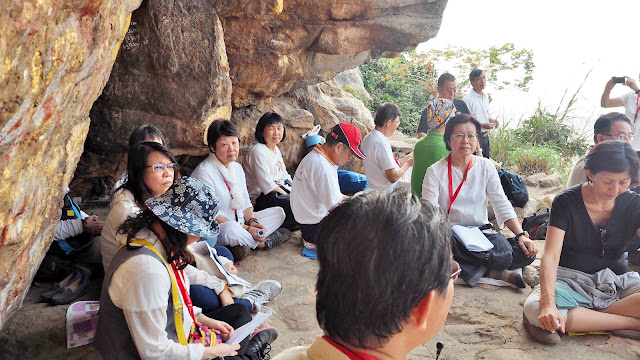



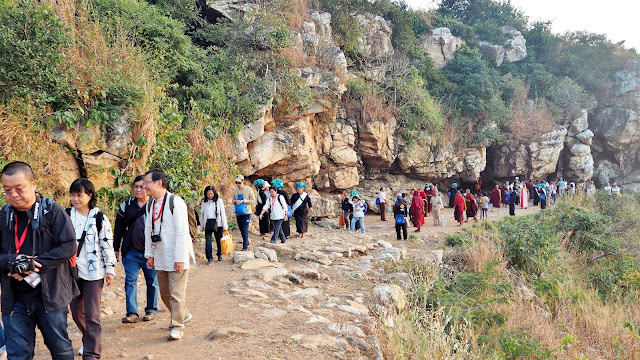


Ching, Thanks for sharing. Very beautiful pics and well documented. I've gained some fascinating insights into the life and culture of India. Keep up the good job! Regards, Christine
ReplyDeleteThank you very much Mr Ching for sharing your Buddhist Pilgrimage Adventure to India. I am very sure all of you must have obtained the highest merits in Buddhism, the Buddha, Dharma and the Sangha or the Holy Triple Gem. Sadhu, Sadhu, Sadhu.
ReplyDeleteHi Ching, Annie & I indeed are very lucky to meet many GREAT PEOPLE like you in this trip. Your unselfish input and fascinating Blog really is helpful. We greatly appreciate and value what you've done. Please let us know whenever you're in PJ and we look forward to catching up with you again.
ReplyDeleteLeong Yew Joo
Director
FM PROMOS SDN BHD
Dataran Prima
43-5, Jln PJU 1/39, Block C2
47301 Petaling Jaya
Selangor
Malaysia
T: 603-7880 3169
F: 603-7880 8007
M:6012-377 4608
E: leong@fmpromos.com
Thank you Ching for sharing. Sadhu Sadhu Sadhu.
ReplyDelete